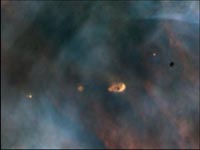![]()
Stellar
Formation
by
Don Ware

Hubble telescope image of stellar formation in Orion
![]()
![]()
![]()
Why
do stars form?
Stars form because of gravity. Gas and dust clouds which readily exist in our galaxy are the building blocks of stars, they contain the raw material hydrogen from which stars get their fuel to begin shining.
Why the dust and gas collapse to form stars at all is still not well understood, we know that stars form more readily in the spiral arms of galaxy, along the boundary of the arm, in which the galaxy is spinning. Possibly the compression of the gases along the arms creates the conditions which cause the dust and gas to begin swirling, much like the eddies and currents in a river where the piers of a bridge interrupt the flow of water.
Shock waves from nearby supernova's can cause star formation, as well as trigger supernova explosions in stars along the shock wave.
Most stars are formed inside huge molecular clouds. One such cloud can be seen in the sword of Orion (the Orion Nebula). Forces here would resist the formation of stars, because of the internal motions of these clouds and because of heating effects of nearby stars in the cloud, but none the less, stars continue to form and quite readily. It may be that as the cloud passes through a density-wave pattern in the spiral arms of our galaxy, that the gravitational collapse is triggered.
Once the collapse starts, instabilities cause the cloud to divide into smaller fragments (Jean's mass). At first radiation can easily escape, but eventually the cloud density increases and the fragmentation ends. These final fragments are where protostars are formed, and they take on a life of their own, continuing to collapse individually.
As the protostar continues to collapse, the temperature rises steadily, and gradually, it is thought, depending on the mass of the cloud this can take 50 million years, but larger masses can take as little as 100,000 years.
When the core of the protostar reaches 10 million degrees Kelvin, nuclear fusion of hydrogen begins, and the star is formed with a flash. The outward pressure from nuclear fusion will stop any further collapse of the star. It is at this point the star reaches the main sequence of the Hertzberg-Russel diagram.
The solar winds from the new star will disperse any remaining dust and gas near the star, you can see this in the Pleiades (M45), in which hot young stars are just emerging from their stellar cocoons.
![]()
![]()
copyright © Peoria Astronomical Society 1994-2004.
